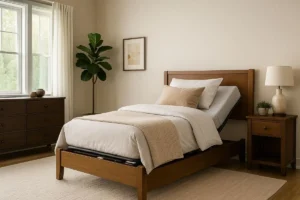The bedroom is one of the most intimate spaces in the house—where we rest, change clothes, reflect, and seek comfort. For people with reduced mobility or physical disabilities, the bedroom needs to go beyond comfort: it must be a functional, safe, and accessible space, without losing its coziness.
Even in small environments, it’s entirely possible to design an accessible bedroom that respects the needs of its user. With careful planning and smart choices, comfort and practicality go hand in hand.
1. Strategic Bed Placement
The bed is the central element of the bedroom and should be positioned to allow easy circulation. Ideally, there should be at least 80 cm of free space on each side to accommodate a wheelchair or walker.
The bed height should be between 45 cm and 50 cm from the floor, facilitating sitting down and standing up. Beds that are too low or too high make transfers difficult and increase the risk of falls.
If possible, choose adjustable beds that allow height and inclination changes. These are especially useful for bedridden individuals or those with severe mobility restrictions.
2. Accessible and Safe Furniture
Avoid excess furniture and prioritize pieces with a clear purpose. Nightstands with easy-to-open drawers, wardrobes with light doors, and D-shaped handles are more user-friendly.
In small bedrooms, custom-made furniture is a great option to maximize space without compromising movement. Choose surfaces with rounded edges to prevent injuries from accidental bumps.
If the user uses a wheelchair, ensure there’s enough room to turn (about 1.20 m in diameter) and that frequently used areas are no higher than 1.20 m from the floor.
3. Safe and Level Flooring
As in other rooms, bedroom flooring should be non-slip, level, and easy to clean. Avoid loose rugs with fringes or folds, as they can cause tripping or hinder wheelchair movement.
If you want to add thermal and visual comfort, choose flat rugs with non-slip backing or install fitted carpets. The key is to keep the path clear and safe.
4. Soft and Functional Lighting
Bedroom lighting should offer visual comfort and functionality. Opt for indirect ceiling lighting to avoid glare and reflections. Bedside lamps with touch buttons or sensors are excellent for nighttime use.
Install switches at an accessible height (between 90 cm and 1.10 m), or even better, use voice-controlled or app-operated lighting systems.
Night lighting, such as LED strips under the bed or along the floor, adds extra safety—especially for those who wake up at night.
5. Adapted Closets and Wardrobes
Access to clothing, shoes, and personal items should be simple and intuitive. For wardrobes, prefer sliding doors and low shelves, lightweight drawers, and pull-down hanging rods.
If the wardrobe is too tall, use labeled organizers and accessible boxes. A dresser next to the bed can help store frequently used items within reach.
6. Warm Colors and Welcoming Decor
The bedroom should also promote well-being. Use light and neutral tones to visually expand the space and create a relaxing atmosphere. Colors like beige, white, light gray, or pastel blue work very well.
Decorative items such as framed photos, pillows, or small art pieces add personality—just make sure they don’t obstruct movement or interfere with furniture use.
7. Tech That Makes Life Easier
Assistive technology is very welcome in bedrooms. Voice-controlled lights, air conditioning, or TV systems enhance autonomy. Smart speakers, digital locks, and smart plugs can be integrated subtly and stylishly.
Adjustable beds with remote control and automatic functions for head and foot positioning are ideal for those who spend extended periods resting.
8. Proper Ventilation and Thermal Comfort
Natural ventilation is always recommended, but in small rooms, fans or air conditioning are often necessary. Make sure their controls are accessible and simple to operate.
For individuals with thermal sensitivity, maintaining a pleasant temperature is crucial for a good night’s sleep and daytime comfort.
Final Thoughts
Creating an accessible and cozy bedroom is more than adapting a space—it’s about valuing dignity, well-being, and independence. Even in small rooms, it’s possible to design a functional, beautiful, and personal environment with thoughtful planning and empathy.
True comfort begins when the space adapts to the person—not the other way around. And fortunately, that is within reach of any home.

